This sweet, nutty and crunchy Peanut Chikki Recipe (called Peanut Brittle in English and Gajak in Hindi) is a popular winter sweet snack in India. They are easy to make and you only need two key ingredients! Grab some jaggery and peanuts and make this delicious sweet in less than 30 minutes.
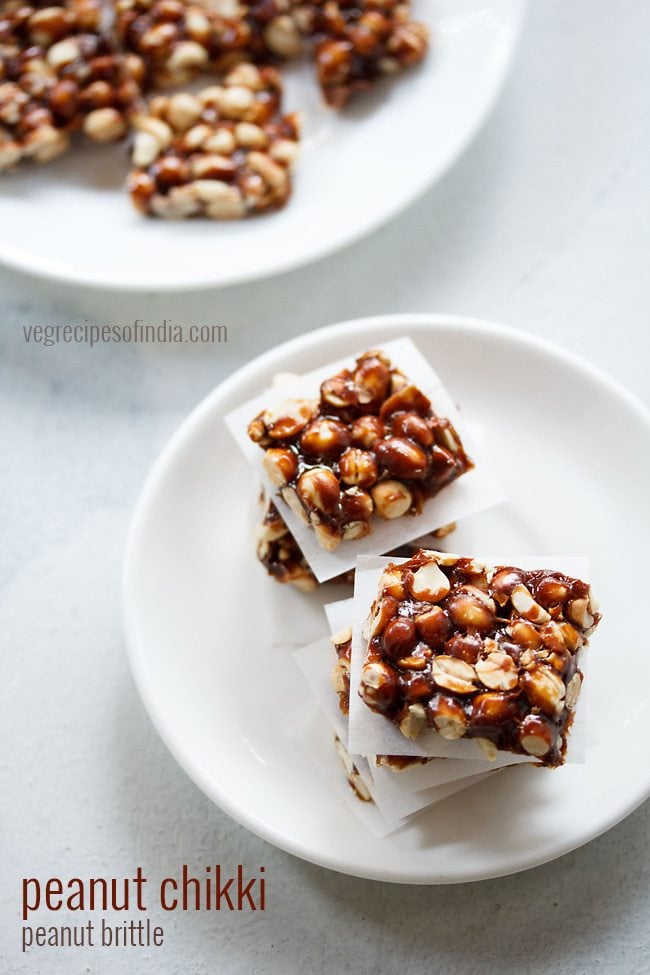
Table of Contents
About Chikki
Chikki is an Indian sweet candy made traditionally made with jaggery and nuts like roasted peanuts or cashews or almonds and even coconut.
Some variants are made with roasted chana dal (hulled black chickpeas), puffed rice, roasted amaranth seeds or sesame seeds, or a mix of various nuts and dry fruits.
This mouth-watering candy is referred to as Chikki in Marathi and Gajak in Hindi. Chikki is very popular with kids and are usually made and enjoyed during the winter season in India and the Makar Sankranti festival.
Jaggery is Indian unrefined cane sugar made by simmering fresh sugar cane juice in large iron woks until it reduces to a very thick consistency. It has a unique flavor profile and can be compared to that of muscovado sugar or molasses.
Chikki are available in supermarkets. However, homemade chikki or gajak are superior as they don’t include preservatives.
Liquid glucose, sugar, corn syrup and other preservatives are added to chikki sold in supermarkets to give them a longer shelf life as well as to improve their texture.
You only need 2 ingredients to make these mouth-watering peanut chikki recipe. They are pretty simple to make however, it is crucial that you get the jaggery syrup right.
Cook the syrup until it gets to the hardball stage for the best results. Another important step involves removing peanut skins from the peanuts. If the peanuts you are using are skinless then you can skip this step!
Some other popular sweets eaten during Sankranti-Pongal-Lohri are Til Ladoo and Sweet Pongal.
How to Make Peanut Chikki Recipe
Roast Peanuts
1. Heat a thick-bottom heavy kadai or pan and add 1 cup of peanuts.
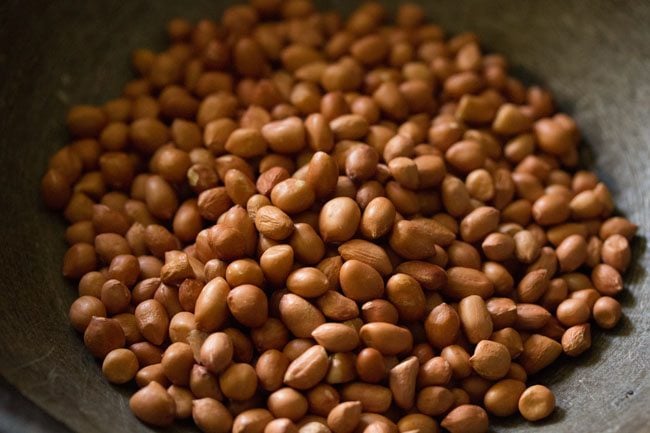
2. Roast the peanuts on a low to medium heat and stir from time to time until they become crunchy.
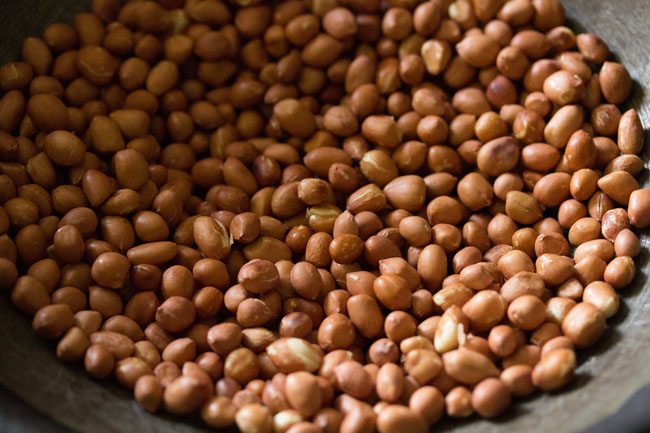
3. Roast until black spots appear on the peanuts, taste them and make sure they have some crunch. If the peanuts are still raw then roast them for longer.
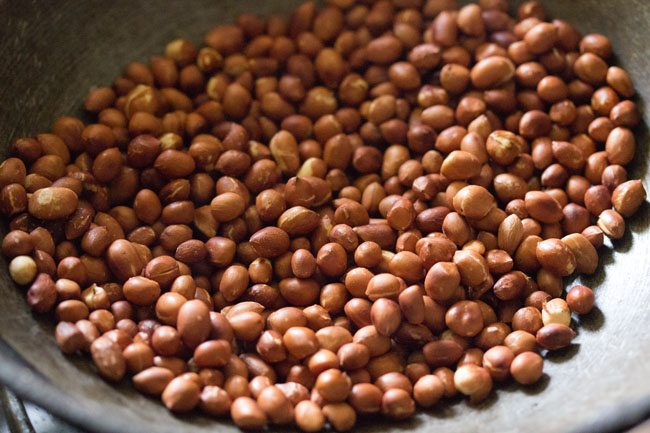
4. Once the peanuts are roasted add them to a separate plate or tray and leave them to cool down.
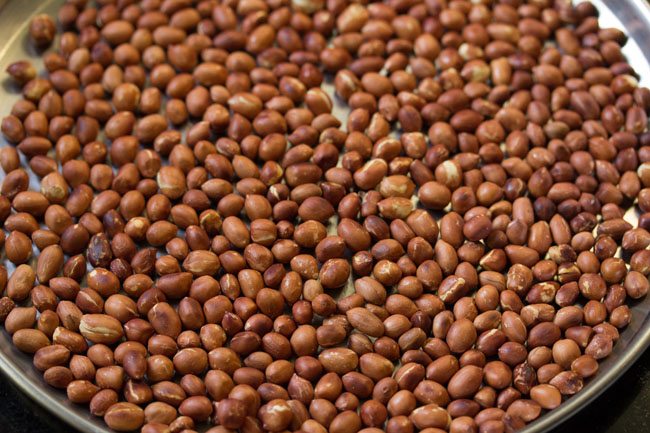
5. Grease the back of a metal baking tray, steel plate, or marble board with oil or ghee. You can also brush a parchment paper kept on a sturdy surface with oil or ghee.
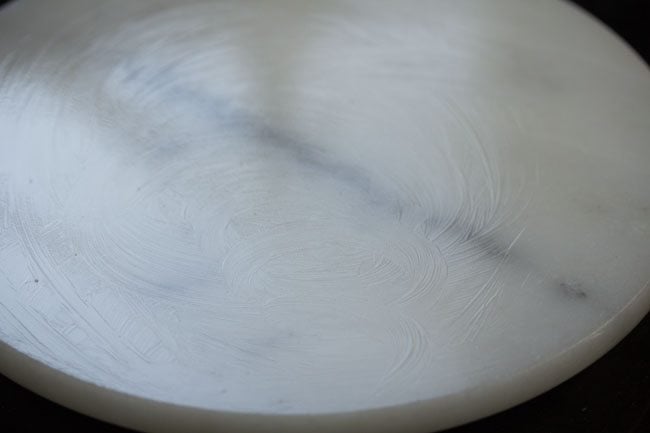
6. Once the peanuts cool down, rub them between your palms and peel off the husks.
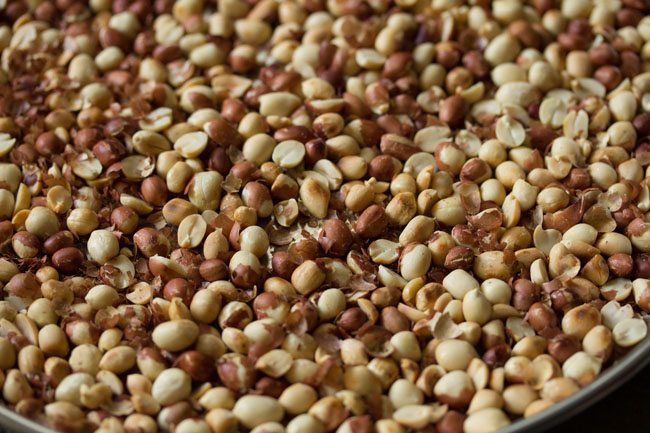
7. Add peanuts to a sieve or winnow with large perforations and sift to remove husks. Remove husked peanuts and set them aside.
TIP 1: Using a sieve or winnow will help to remove the husks easily and quickly.
TIP 2: If you prefer you can crush the peanuts coarsely with a pestle or in a spice-grinder or mixer-grinder.
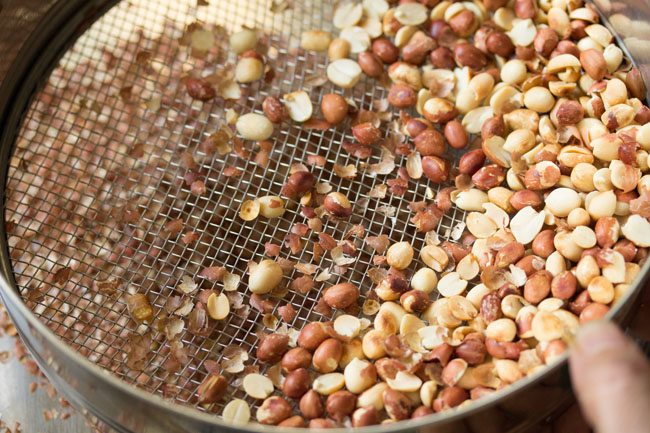
Make Jaggery Syrup
8. Add ½ a cup of jaggery powder or chopped jaggery to the same kadai or pan. Strain the jaggery if there are any impurities.
TIP: If you don’t have jaggery powder then you can use a jaggery block instead. Chop it finely and measure the chopped jaggery in a ½ cup measuring cup.
NOTE: Here I have used organic jaggery powder and it has worked perfectly for me. You could use the regular jaggery, organic jaggery or your preferred brand. Just remember not to use evaporated sugar cane juice.
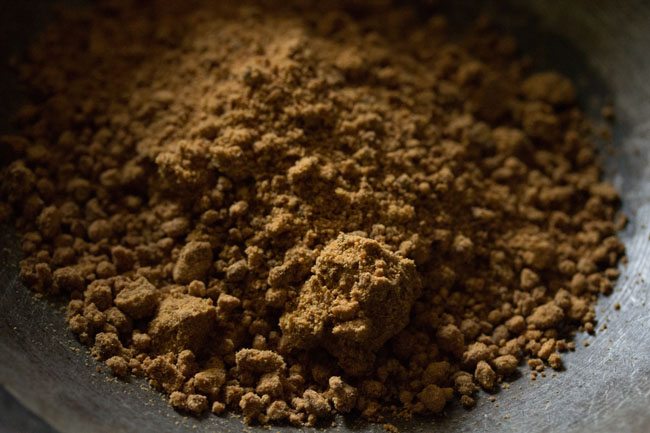
9. Add 2 tablespoons of water.
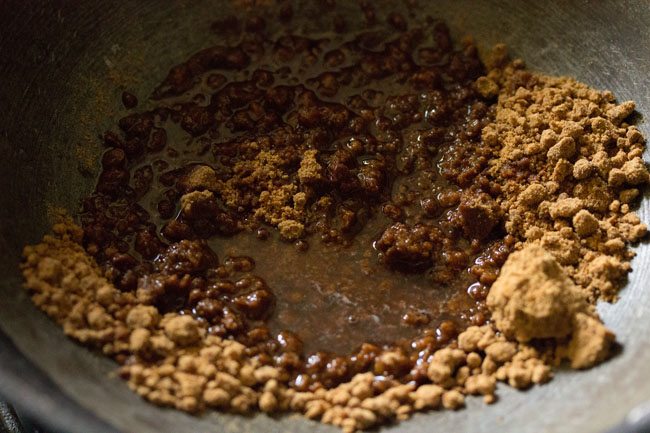
10. Heat the kadai (wok) or pan on a low flame. Then, use a spatula or spoon to stir the jaggery syrup until the jaggery dissolves.
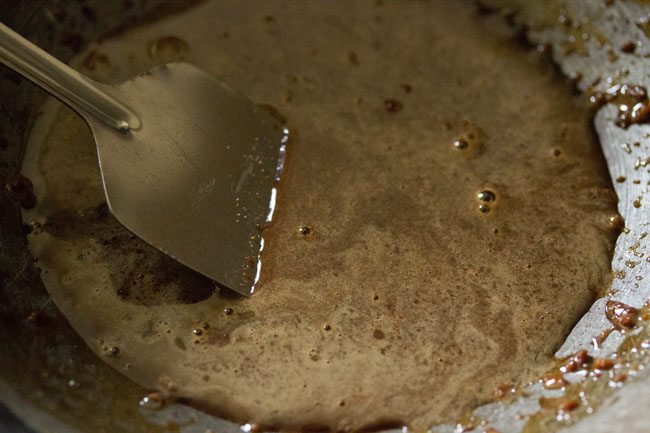
11. Continue to stir the mixture continuously.
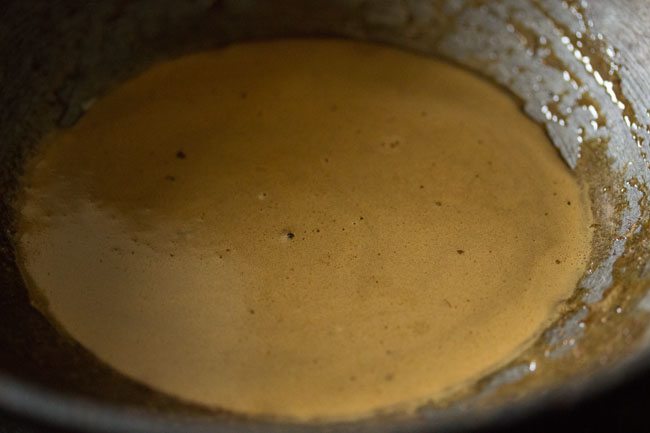
12. The jaggery syrup should begin to thicken. Continue to stir the syrup on a low flame.
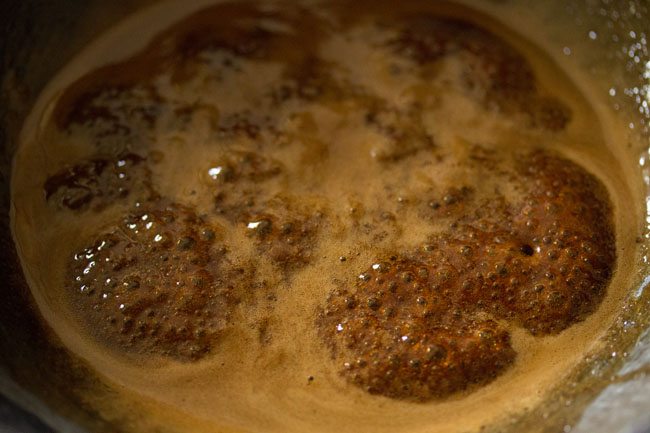
13. Add cold water to a bowl and keep it close by. Then add a few drops of jaggery syrup to the water to check the consistency of the jaggery syrup as it cooks.
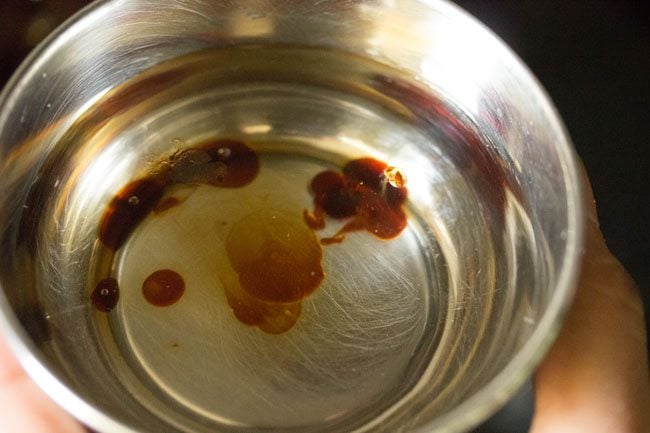
14. The syrup will thicken and begin to bubble.
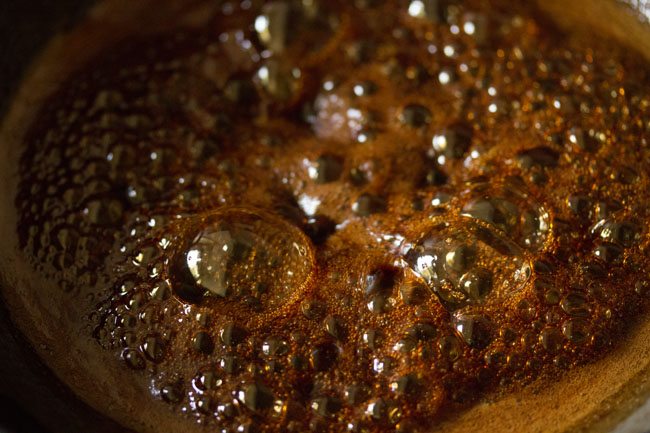
15. Continue to cook jaggery syrup on low heat and stir often.
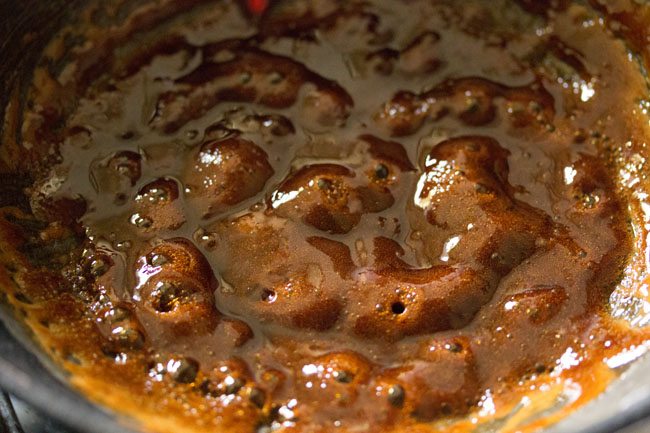
16. Cook the mixture until it starts to thicken. The color of the syrup will change and darken. At this point, the syrup should be stirred non-stop to prevent burning.
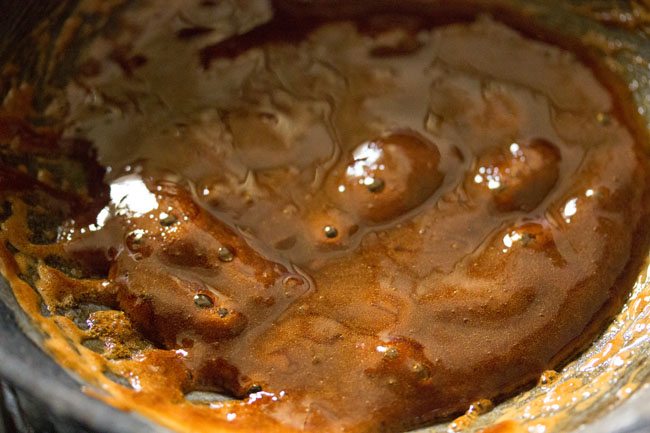
17. Eventually the syrup should resemble molten liquid mass.
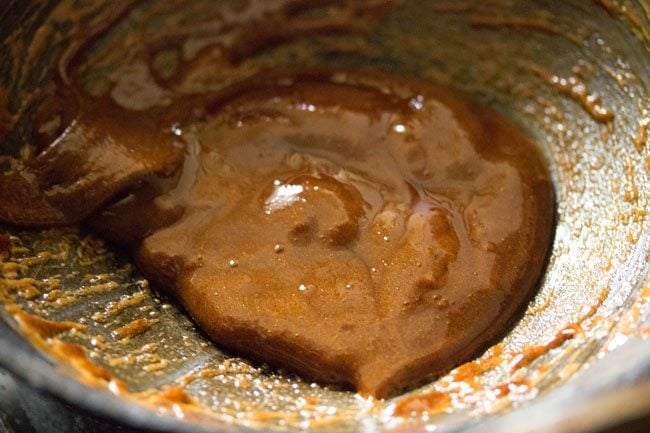
18. Check the consistency by adding a few drops of the jaggery syrup to the cold water. The jaggery syrup should be firm, brittle, and snap easily. This is referred to as the hard ball stage.
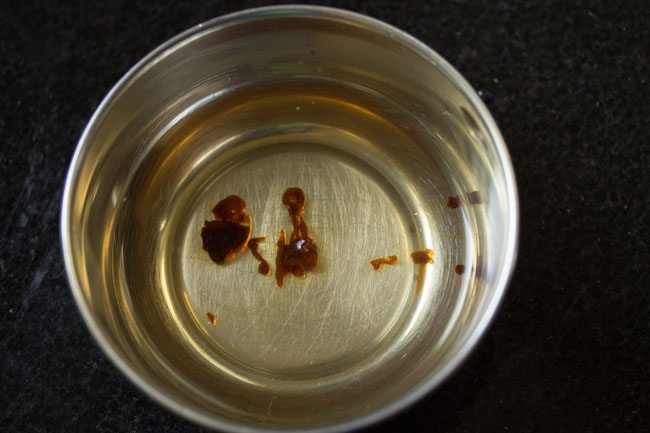
Make Peanut Chikki
19. Once the jaggery syrup is the right consistency, add the peanuts quickly.
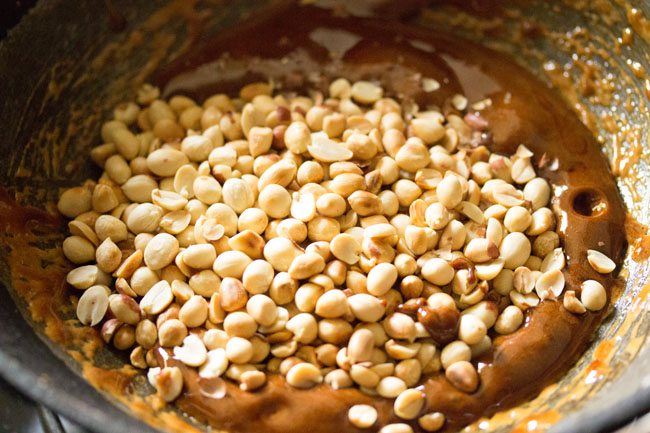
20. Mix the jaggery syrup and peanuts until well combined.
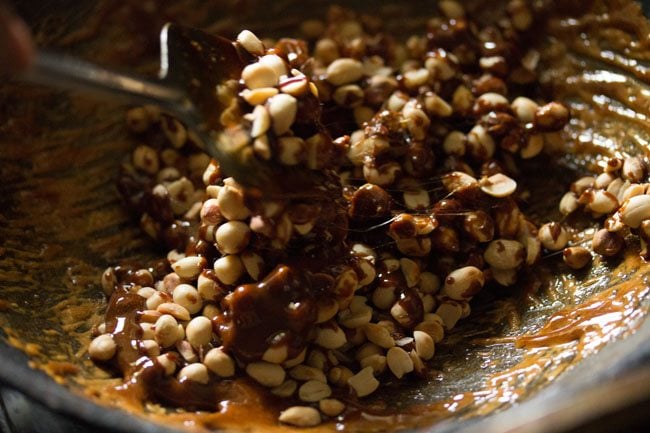
21. Switch off the heat and quickly pour the chikki mixture onto a greased plate or marble board.
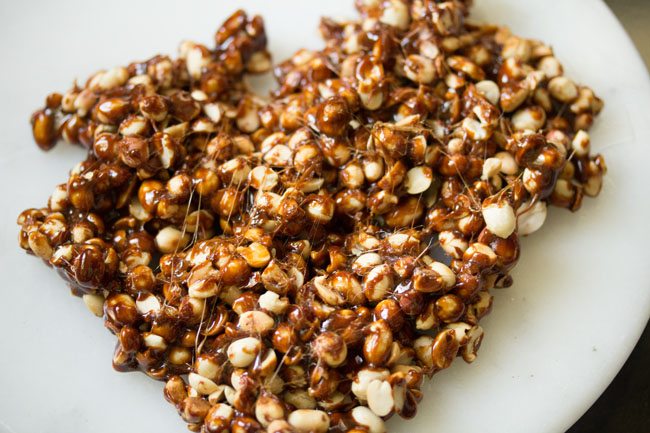
22. Place foil, butter paper, or parchment paper on the chikki mixture. Use a rolling pin to flatten the chikki mixture into one even layer.
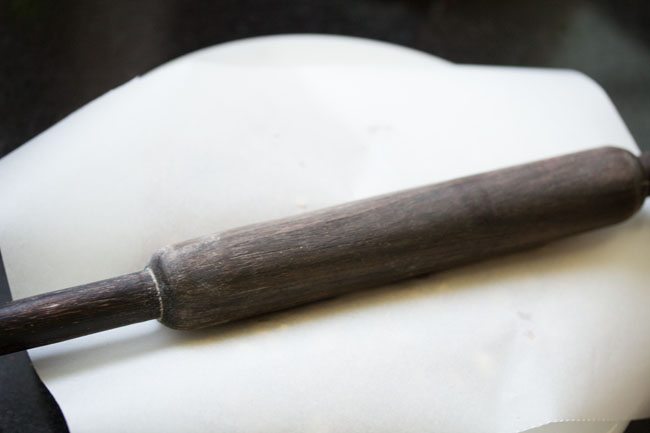
23. After rolling the chikki mixture, remove the parchment paper.
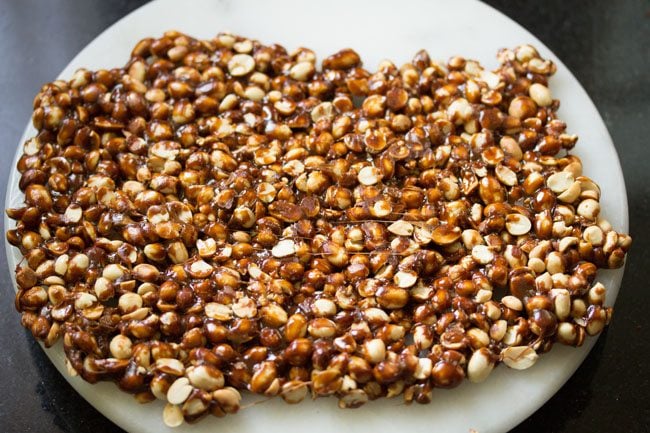
24. After removing the paper, carefully cut the chikki into equal-sized squares.
Tip: Make sure the chikki is hot when rolling and cutting. If the chikki is cold then it will be difficult to cut and roll.
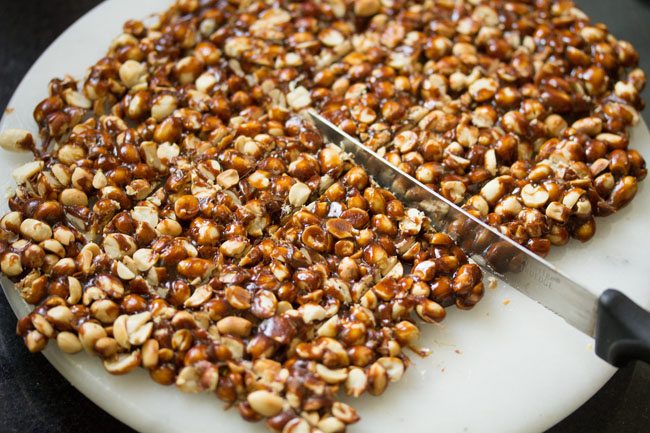
25. Leave the chopped chikki to cool at room temperature.
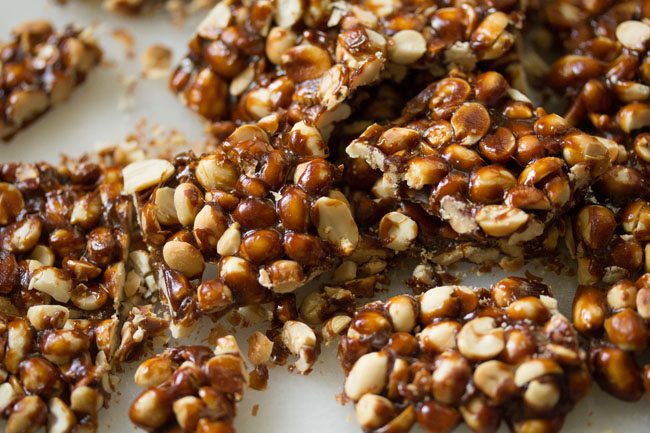
25. Once the Peanut Chikki has cooled down break and serve. If you want to serve the chikki or gajak at a later time then store it in an airtight jar at room temperature.
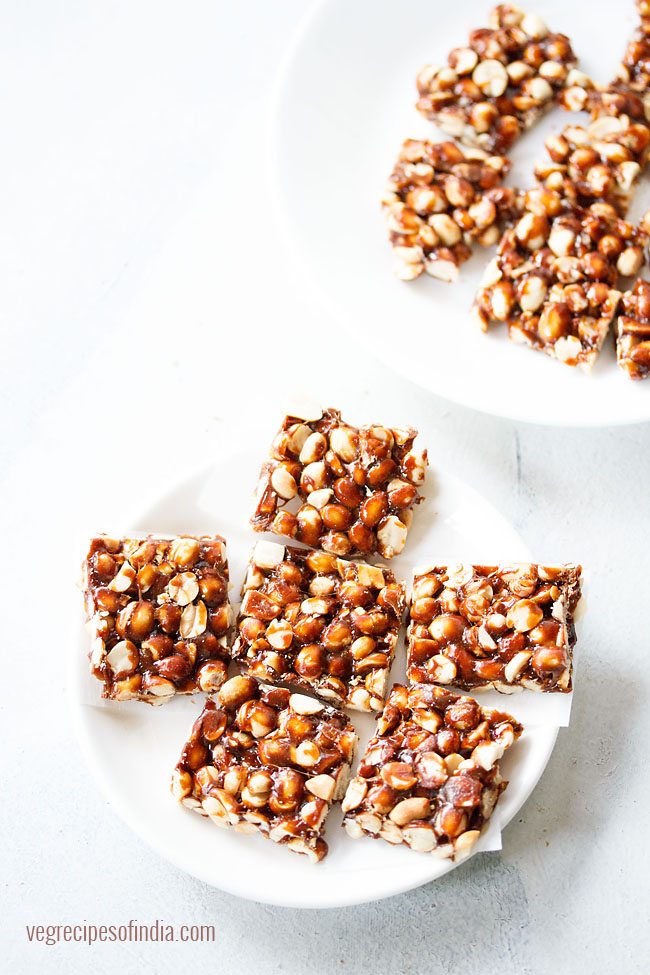
Expert Tips
- Jaggery syrup: Make sure you pay a lot of attention when making the jaggery syrup. It is essential that the syrup is cooked to the hard boiled staged to get the best results. Add a drop of jaggery syrup to a bowl of cold water to check the consistency. Be attentive when cooking jaggery syrup. If it is not cooked for long enough then the chikki or gajak will be chewy and sticky.
- Hard ball stage: Do not cook the syrup beyond the hard ball stage as the peanut chikki will become too hard. To avoid this cook the jaggery syrup on a low heat and stir it continuously.
- Roasting: You need to roast the peanuts until they are crunchy to make the best chikki recipe. If the peanuts still have husks then rub them between your palms to remove the husks or use a sieve. Do not skip this step as you don’t want peanut skins in the chikki.
- Slicing: After the chikki mixture has been rolled you will need to cut it into equal sized squares. It is crucial to chop when the chikki is still hot. If the chikki sets and cools it will be difficult to chop the candy.
- Batch: This decadent sweet can be made in large batches! Double or triple this peanut chikki recipe to feed a crowd. But remember that it will be an arm exercise as you will need to stir the jaggery liquid many times.
FAQs
Maganlal Agarwal is believed to have originally invented chikki . This delicious Indian candy was invented in the 19th-century at the Lonavala hill station which is near to Mumbai.
It is believed that Maganlal Agarwal invented this sweet using a combination of jaggery, peanuts, and ghee. It was originally named gud dani.
Chikki can be stored in an airtight jar for up to 2 months at room temperature.
Yes, you can replace jaggery with white sugar or brown sugar to make chikki recipe. Cook the sugar until the syrup gets to the hard ball stage. A candy thermometer will also help you to check if the syrup has reached the hard ball stage.
If your chikki is sticky then this implies that the jaggery syrup was not cooked for long enough.
No, chikki and pralines are not the same. Chikki is an Indian candy made with jaggery and nuts like cashews, peanuts, almonds or roasted cereals and lentils. Whereas, French praline is made with caramelized sugar and slivered almonds or nuts like hazelnuts, cashews or pecans.
More Indian Winter Sweets!
Ladoo Recipes
Ladoo Recipes
Ladoo Recipes
Sweets Recipes
Please be sure to rate the recipe in the recipe card or leave a comment below if you have made it. For more vegetarian inspirations, Sign Up for my emails or follow me on Instagram, Youtube, Facebook, Pinterest or Twitter.
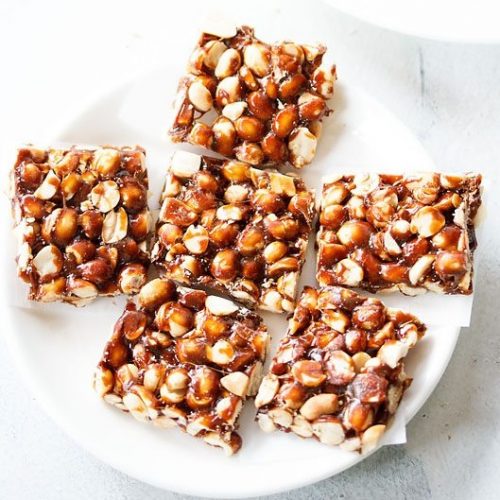
Peanut Chikki Recipe (Peanut Gajak)
Ingredients
- 1 cup peanuts – 160 grams, unsalted and un-roasted
- ½ cup jaggery powder or chopped jaggery (tightly packed) – 100 grams
- 2 tablespoons water
- 1 to 2 teaspoons oil or ghee for greasing
Instructions
Roasting peanuts
- Heat a thick bottomed heavy kadai or pan. Add the peanuts in it.
- On a low to medium-low heat, roast the peanuts stirring often till they become crunchy.
- Roast till you see some black spots on the peanuts and they should have a crunch in them. Taste a few peanuts and if it feels raw, then continue to roast.
- Once the peanuts have got roasted well, then remove them in a separate plate or tray. Let them cool down.
- Grease the back of a metal tray or back of a steel plate or a marble board with some oil or ghee.
- When the peanuts have become warm or cool down, then rub them between your palms. The husks peels of easily.
- Now to get rid of the husks, you can use a winnow or use a sieve with large perforations. Add the peanuts in the sieve and sift. The husks will get sifted easily. Remove the husked peanuts and set aside.
Making jaggery syrup
- In the same kadai or pan, take the jaggery powder. You can also use jaggery block and chop it. If there are impurities, then you will need to strain the jaggery syup.
- Add water to the jaggery powder.
- Heat the kadai or pan on a low flame. With a spatula or spoon, begin to stir, so that all the jaggery gets dissolved.
- Keep on stirring the mixture often.
- Cook the jaggery syrup on a low heat with frequent stirrings.
- While the jaggery syrup is cooking, also keep a bowl of cold water where you can check the consistency of the syrup.
- Keep on cooking till the mixture reaches the hard ball stage.
- Add a few drops of the syrup in the cold water. It should be firm, brittle and break or snap easily.
Making peanut chikki
- When the jaggery syrup reaches this hard ball consistency, quickly add the peanuts and give a quick stir and mix very well.
- Switch off the heat and quickly pour the chikki mixture on the greased plate or marble board.
- Then quickly place a foil or a butter paper or parchment paper on the chikki. mixture.
- With a rolling pin roll to even out the chikki layer. Roll to a neat even layer.
- Next remove the paper and then with a knife, cut horizontally and vertically to make squares. Let the peanut chikki cool at room temperature.
- Once cooled, break them and serve peanut chikki. If not serving, then store them in an airtight jar at room temperature.
Notes
- The recipe can be doubled.
- Be attentive when cooking jaggery syrup. If its not cooked till hard ball stage, the chikki will be chewy and stick in the teeth.
- Do not cook beyond the hard ball stage as then the peanut chikki will become too hard.
Nutrition Info (Approximate Values)
This Peanut Chikki recipe from the archives, originally published in January 2017 has been updated and republished on January 2023.
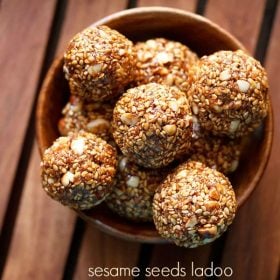
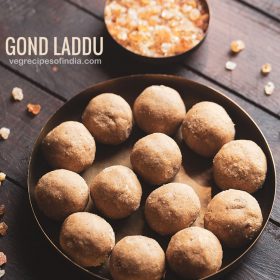
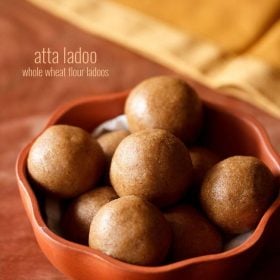
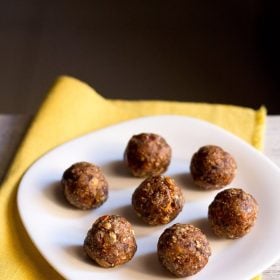
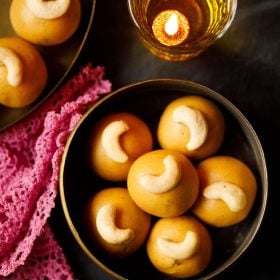
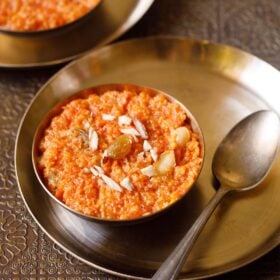
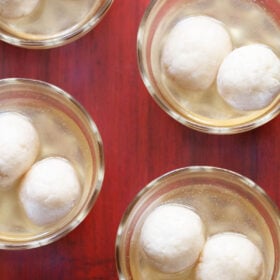
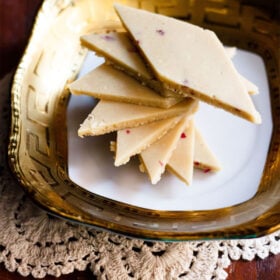








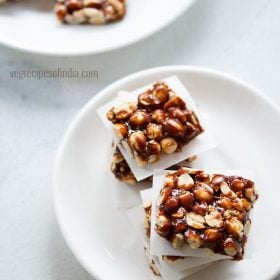
Hi, I m looking for your mix veg fried one recipe but now not finding can you send me the link
I have already sent you the recipe. Kindly check your email.
The recipes posted on Veg Recipes of India are always easy to make and the ingredients are all easily available. My first site to visit for veg recipes is always this one. Thank you Dassanna
thank you very much farida. most welcome and happy cooking. wish you all the best.
Awesome✊, instead of buying from outside, really making chikki at home is not so difficult, and it’s all bcoz of you mam, thanks for the mouth-watering recipe.
thank you archana.
Very nice way of explanation
thank you.
Hi , your recipe is yummy.. My chikki has been just like jaggery itself.. where did I go wrong.. ? Did I cook it too much?
priyanka, the jaggery has been cooked too much and thus it has become crumbly. whenever sugar or jaggery gets overcooked they become powdery and crumbly.